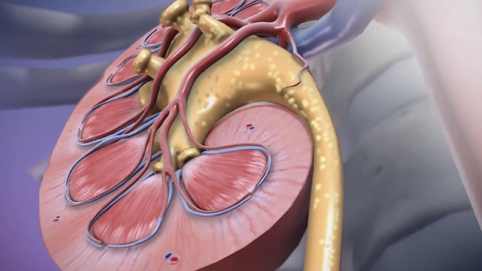
Cranberry for Urinary Tract Infections.
- Urinary Tract Infections:
Urinary tract infection (UTI) affects >150 million people/y worldwide and is the most common urologic disease in the United States, accounting for >$2.6 billion in annual health care expenditures.The most common form of UTI is cystitis, a sporadic uncomplicated UTI in the bladder while complicated UTI is less common. Uncomplicated UTI is more common in women, women have a 50 % risk of a UTI episode over their lifetime, and ∼20–30% experience a subsequent UTI recurrence.
The use of prophylactic antibiotics is currently controversial because of side-effects and antibiotic resistance. The most common therapeutic approach to UTI is the use of antibiotics (e.g., fluoroquinolones); however, women with recurrent UTI often require multiple antibiotic regimens within short periods of time, and antibiotics are also employed as a prophylactic. This use of antibiotics increases women's risk of developing antibiotic resistance. Currently, rates of fluoroquinolone resistance are >20% in many parts of the world, and multiple-resistant strains of the Enterobacteriaceae that produce extended-spectrum β-lactamases are now present or emerging in many communities, including the United States. Moreover, the FDA stated in 2016 that the serious side effects associated with fluoroquinolone antibacterial drugs generally outweigh the benefits for patients with an uncomplicated UTI. Therefore, non-antibiotic methods for UTI prevention are of interest to clinicians, particularly in the treatment of uncomplicated UTI.
 - Cranberry and UTI Prevention:
- Cranberry and UTI Prevention:
Cranberries have been used widely for several decades for the prevention and treatment of urinary tract infections (UTIs). Several clinical studies suggest that consumption of cranberry supplements may decrease UTI occurrence in healthy women, as cranberry-derived compounds (e.g., polyphenolics and A-type proanthocyanidins) may interfere with the adhesion of bacteria to urinary tract epithelial cells,
attenuate the uropathogen reservoir in the gastrointestinal tract, and suppress the inflammatory cascade.
- Mechanism of action:
The mechanism of action of cranberry was thought to be through acidification of the urine contributed to an antibacterial effect, and the current proposed mechanism of action focuses primarily on cranberry’s ability to prevent bacterial binding to host cell surface membranes. potent inhibition of bacterial adherence of Escherichia coli and other gramnegative uro-pathogens, Cranberry has been found to specifically inhibit hemagglutination of E. coli by expression of types 1 and P adhesin through the component compounds fructose and proanthocyanidins. In vitro, antibacterial activity of concentrated cranberry juice against other pathogens such Staphylococcus aureus, Pseudomonas aeruginosa, Klebsiella pneumoniae, and Proteus mirabilis has also been demonstrated.
- Effectiveness:
Cranberry were shown to significantly reduce the risk of UTI recurrence by 35%, and can be an effective nutrition-based non-antibiotic and potential non-pharmacologic approach for generally healthy women to prevent an uncomplicated recurrent UTI. A recent study in children without urological abnormalities showed a 65% reduction of UTI with the use of cranberry.
Cranberry appears to be a safe, herbal choice for UTI prophylaxis and has relatively good tolerability. the use of cranberry for up to 12 months is safe and moderately effective. No significant herb-drug reactions with cranberry have been reported.
References:
- Cranberry Reduces the Risk of Urinary Tract Infection Recurrence in Otherwise Healthy Women: A Systematic Review and Meta-Analysis,The Journal of Nutrition, Volume 147, Issue 12, December 2017, Pages 2282– 2288.
- Effectiveness of Cranberry Capsules to Prevent Urinary Tract Infections in Vulnerable Older Persons: A Double-Blind Randomized Placebo-Controlled Trial in Long-Term Care Facilities, J Am Geriatr Soc. 2014 Jan; 62(1): 103– 110.
- Cranberry for Prevention of Urinary Tract Infections, Continuum Center for Health and Healing, New York, American Family Physician, December 1, 2004 Volume 70, Number 11.